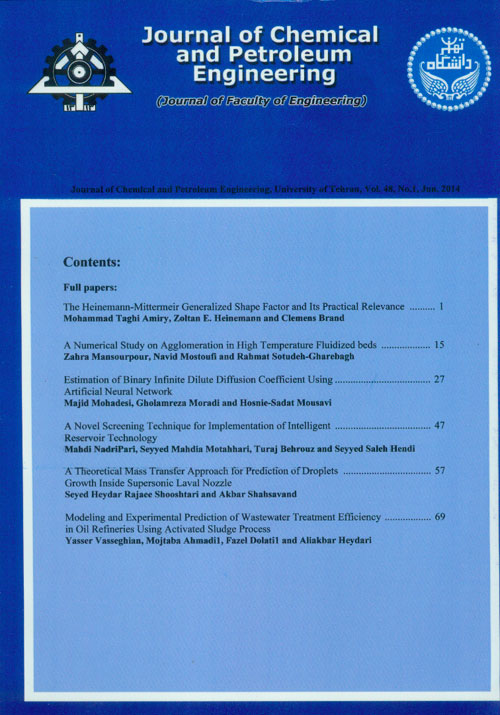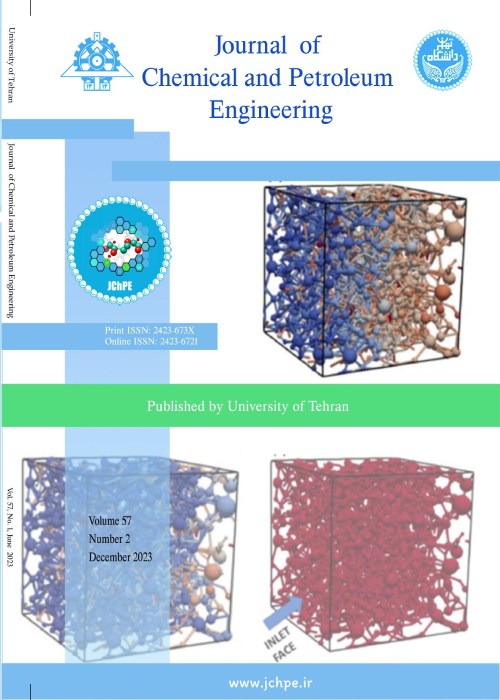فهرست مطالب

Journal of Chemical and Petroleum Engineering
Volume:48 Issue: 1, Jun 2014
- تاریخ انتشار: 1393/03/30
- تعداد عناوین: 6
-
-
Pages 1-13Fifty years ago Warren and Root have introduced the shape factor. This fundamental parameter for modeling of naturally fractured reservoirs has been discussed stormily ever since. Different definitions for shape factor have been suggested which all of them are heuristically based. Recently, Heinemann and Mittermeir mathematically derived - based on the dual-continuum theorem assuming pseudo-steady state condition- a general and proper form of the shape factor formula which can be simplified to the previously published shape factor definitions. This paper discusses the practical relevance of the Heinemann-Mittermeir formula. Its difference to the most commonly used Kazemi et al.formula is its demonstration by fine-scale single matrix block simulation. Furthermore, it is shown that the generally applied isotropy assumption can lead to significantly wrong results. Consequently, the generalized Heinemann-Mittermeir shape factor formula is recommended to be routinely practiced in the industry for more accurate results. The paper tries to present a proper realization of the nature of the shape factor as well as presentation of detailed mathematical and practical approaches for measuring all the required values in order to determine the shape factor for individual matrix rock pieces from outcrops of fractured formations. Performing those measurements routinely is regarded as essential parameter for its usability.Keywords: Shape factor, Fractured reservoirs, Transfer function, Heinemann, Mittermeir, Single matrix block
-
Pages 15-25Soft-sphere discrete element method (DEM) and Navier-Stokes equations were coupled with equations of energy for gas and solids to investigate the process of agglomeration in fluidized bed of polyethylene particles at high temperature. The Newton’s second law of motion was adapted for translational and rotational motion of particles and agglomerates. The cohesive force for polyethylene particles was calculated based on a time dependent model for solid bridging by the viscous flow mechanism. The motion of agglomerates was described by means of the multi-sphere method. By taking into account the cohesiveness of particles at high temperatures and considering real dynamic agglomerates, the fluidization behavior of a bed of polyethylene particles was successfully simulated in terms of increasing the size of agglomerates. Effect of the inlet gas temperature on mass and size of agglomerates was investigated. A mechanistic study in terms of contact time, cohesive force and repulsive force, which are the key parameters in the formation of agglomerates, were also carried out.Keywords: Agglomeration, Discrete element method, Fluidized bed, High temperature solid bridge
-
Pages 47-55Throughout life cycle of oil production wells, it is imperative to have production optimization and real response time to rapid changes of well conditions and more understanding of subsurface otherwise it is the matter of expenditure losing. Smart well capabilities meet aforementioned issues. However there is a key concern in managers'' mind that they have limited budget and several fields'' documents in front. They cannot afford smart well technology for all fields because they know that justification through modeling, simulation and economic evaluation is vital but costly and time consuming. They can apply this box only for one filed. How can they select one field among these fields? In this paper we present a novel screening technique by Analytical Hierarchy Process engine. This technique needs criteria and sub-criteria affecting on smart well potential of fields. Application of this screening technique directed us to prioritize four fields to implement smart well completion. Interestingly; the output of this paper can be used for any set of fields throughout the world.Keywords: Screening criteria, Smart well, Prioritization, Analytical hierarchy process, Sensitivity analysis
-
Pages 57-68Proper estimation of droplet growth rate plays a crucial role on appropriate prediction of supersonic separators performance for separation of fine droplets from a gas stream. Up to now, all available researches employ empirical or semi-empirical correlations to define the relationship between droplet growth rate (dr/dt) and other operating variables such as temperatures (T and TL), Pressure (P) and condensation rate (mL). These empirical or semi-empirical equations are developed for pure component systems and should not be extended to binary or multi-components systems. A novel theoretical approach is presented in this article which provides a fundamental equation to find the droplet growth rate by resorting to mass transfer equations. The new model uses a combination of mass transfer equations and mass and energy balances to estimate the droplet growth rate, droplet temperature and condensation rate simultaneously. Although the simulation results indicate that the proposed method provides impressive results when validated with several real experimental data, however, the main advantage of the present approach is that it can be easily extended to binary or multi-components systems. To the best of our knowledge, the proposed approach has not been addressed previously.Keywords: Condensation, Growth rate, Laval nozzle, Mass transfer, Supersonic separator
-
Pages 69-79In this study, activated sludge process for wastewater treatment in a refinery was investigated. For such purpose, a laboratory scale rig was built. The effect of several parameters such as temperature, residence time, effect of Leca (filling-in percentage of the reactor by Leca) and UV radiation on COD removal efficiency were experimentally examined. Maximum COD removal efficiency was obtained to be 94% after final testing. An artificial neural network (ANN) was applied to evaluate the effect of operational parameters on the efficiency as the next step. A two-layered ANN provided the best results, using Levenberg–Marquardt back propagation learning algorithm (trainLM) in which tansig and purelin used as transfer functions in the hidden and output layers. Furthermore, the application of three neurons in the hidden layer caused to gratify network training while overfitting was hindered. ANN model, provided a good estimation for correlation coefficient and the mean square error (MSE) which calculated 0.997 and 0.5 × 10-3 respectively.Keywords: Wastewater treatment, COD Removal, Activated sludge, Artificial neural network


